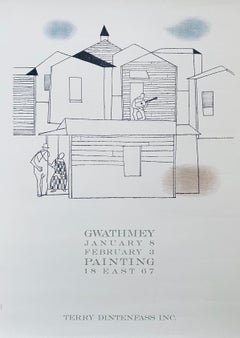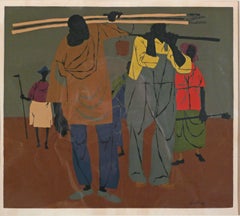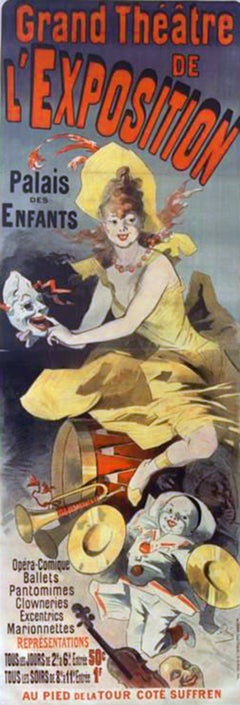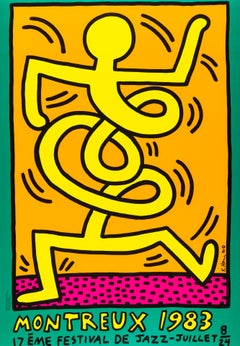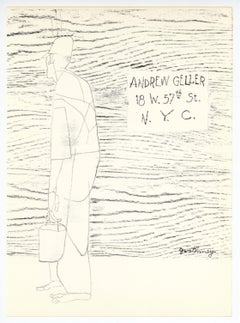Robert Gwathmey Art
American, 1903-1988
Robert Gwathmey became an artist known for his Social Realist depictions of life in the rural South. He was one of the first white artists to create dignified images of African-American people and did so in a style that was Modernist with many geometric forms and bold coloration. Although he lived intermittently in Pennsylvania and in the South, he spent most of his 45-year career in New York City, where his studio was at 1 West 68th Street. Frequently, he returned to the South, where he became concerned about the problems dividing blacks and whites.
to
1
6
2
4
2
3
1
2
Overall Height
to
Overall Width
to
3
6
3
3
3
2
2
2
1
1
1
6
2
1
2
7
6,996
3,348
2,513
1,213
4
1
1
1
1
Artist: Robert Gwathmey
"Girl with Guitar" Robert Gwathmey, Music, Southern Social Commentary, Modernism
By Robert Gwathmey
Located in New York, NY
Robert Gwathmey
Girl with Guitar, 1965
Signed upper right
Oil on canvas
16 x 20 inches
Provenance:
The artist
ACA Galleries, New York
Mr. Moses Asch, New York
Terry Dintenfass Galle...
Category
1960s American Modern Robert Gwathmey Art
Materials
Canvas, Oil
Migrant, Signed and Framed Screenprint by Robert Gwathmey
By Robert Gwathmey
Located in Long Island City, NY
Born in Richmond, Virginia, Robert Gwathmey became an artist known for his Social Realist depictions of life in the rural South. He was one of the first white artists to create digni...
Category
1970s American Modern Robert Gwathmey Art
Materials
Screen
Vintage Lithograph Poster Robert Gwathmey Terry Dintenfass Gallery NYC
By Robert Gwathmey
Located in Surfside, FL
Robert Gwathmey (January 24, 1903 – September 21, 1988) was an American social realist painter. His wife was photographer Rosalie Gwathmey (September 15, 1908 – February 12, 2001) and his son was architect Charles Gwathmey (June 19, 1938 – August 3, 2009).
Robert was born to Robert Gwathmey Sr. (1866-1902) and Eva Mortimer Harrison (1868-1941). His half sisters were Kathrine and Ida Carrington. Robert Sr. was killed at work by an explosion and his wife was killed in a vehicular accident.
Gwathmey attended North Carolina State College in Raleigh, studying business from 1922-1923. He did not think this path would take him anywhere so he got a job on a freighter and later studied a year at the Maryland Institute of Design in Baltimore. The Pennsylvania Academy of the Fine Arts in Philadelphia is where he completed his education of the arts; he spent four years there.
In 1929 and 1930, Gwathmey was the winner of the Cresson Traveling Scholarship, which allowed him the opportunity to study abroad in the summers. He traveled to Paris, Madrid, Barcelona, Genoa, Pisa, Florence, Venice, Vienna, Munich, and London.
Throughout his studies, Robert Gwathmey was influenced by many artists including Pablo Picasso, Henri Matisse, Vincent van Gogh, and Rufino Tamayo from the European modernists, French satirist Honoré Daumier, realist painter Jean-François Millet along with Daumier and Degas.
Gwathmey is known for simplifying compositions and using symbolic abstraction to create his messages. His style is recognized by the color, shapes, and figures he uses in his artwork.
When asked about being a "social artist" this was his reply: "I'm a social being and I don't see how you can be an artist and be separate....Artists have eyes...You go home. You see things that are almost forgotten. It's always shocking."
After finishing school, Robert Gwathmey was a professor at several colleges: Temple University in Philadelphia (1930-1932), Beaver College in Glenside, PA (1930-1937), Carnegie Institute of Technology, Pittsburgh, PA (1939-1942), the Cooper Union School of Art, New York City (1942-1968), New School for Social Research, New York (1946-1949), and Boston University (1968-1969). He was an instructor to artists Faith Ringgold[8] and Alvin Carl Hollingsworth...
Category
Mid-20th Century Modern Robert Gwathmey Art
Materials
Lithograph
NON-FICTION
By Robert Gwathmey
Located in Portland, ME
Gwathmey, Robert. NON-FICTION. Color screenprint, 1941 (Williams, 5).
Signed "Gwathmey" in ink within the image, lower left. Edition size
not known. 16 7/8 x 13 1/2 inches, 427 x 34...
Category
1940s Robert Gwathmey Art
Materials
Screen
MIGRANT
By Robert Gwathmey
Located in Portland, ME
Gwathmey, Robert (American 1903-1988). MIGRANT. Screenprint, 1978. An Artist's Proof aside from the edition of 100. Signed in pencil and inscribed "A/P.". 27 3/4 x 18 3/4 inches (ima...
Category
1970s Robert Gwathmey Art
Materials
Screen
END OF THE DAY
By Robert Gwathmey
Located in Portland, ME
Gwathmey, Robert (American, 1903-1988). END OF THE DAY. Williams 4.
Screenprint in colors, 1944.
Edition size not known. Signed in ink, lower right, within the image.
12 1/4 x 14 ...
Category
1940s Robert Gwathmey Art
Materials
Screen
Related Items
Grand Theatre de l’Exposition, from Les Maîtres de l'Affiche
By (after) Jules Cheret
Located in New York, NY
This lithograph in colors with raised chop mark was printed by Imprimerie Chaix in Les Maîtres de l'Affiche, 1899, on fine woven, heavy stock paper. Measures 15 ¾ x 11 3/8 (40 x 29 c...
Category
19th Century Modern Robert Gwathmey Art
Materials
Lithograph
Montreux Jazz Festival -- Screen Print, Pop Shop by Keith Haring
By Keith Haring
Located in London, GB
Montreux Jazz Festival, 1983
Keith Haring
Screenprint in colours, on wove
Printed by Serigraphie Uldry Bern, Switzerland
Published for the Montreux Jazz Festival
Sheet: 100 × 70 cm...
Category
1980s Contemporary Robert Gwathmey Art
Materials
Screen
H 39.38 in W 27.56 in
Series - Les Lavandières by Lélia Pissarro - Screenprint
By Lelia Pissarro
Located in London, GB
SOLD UNFRAMED
Series - Les Lavandières by Lélia Pissarro (B. 1963)
Serigraph
38 x 48 cm (15 x 18 ⁷/₈ inches)
Signed and numbered
Printed in an edition of 300
Artist's Biography:
B...
Category
21st Century and Contemporary Post-Impressionist Robert Gwathmey Art
Materials
Screen
Original Mardi Gras New Orleans 1978 festival serigraph poster
Located in Spokane, WA
Original Mardi Gras, New Orleans, 1978 linen-backed poster. Dressed up in what would be an American Indian costume with full headgear, he is holding a shield with a horse on it. Indian decoration on the footwear. Signed and numbered.
I believe this has to deal with Big Chief leading his Congo Nation Mardi Gras Indian group. Zulu Parade. Many of the original Mardi Gras jazz posters...
Category
1970s American Modern Robert Gwathmey Art
Materials
Screen
H 32 in W 23 in D 0.05 in
Modern Reclining Nude Study of Red Haired Woman
By Patricia Gren Hayes
Located in Soquel, CA
Modern nude study of red-haired woman reclining seated by American painter, Patricia Gren Hayes (b. 1932), 1979.
Signed and dated on verso
Provenance: Purchased as part of larger collection of artist's work
Unframed.
Canvas size: 16"H x 20"W.
Patricia Gren Hayes (American, b. 1932) is a Bay Area Figurative & Feminist Art Movement artist who studied at Winnipeg Public Art School in 1950. She received early recognition in Museum and Gallery competitions and exhibitions and was awarded a Special Education in Art recognition by the Winnipeg Museum of Fine Art, and was awarded a scholarship to the Banff College of Fine Art. Further studies were at The University of Manitoba.
She was a Member of Winnipeg Free Press Sketch Club and was a Cartoonist and paste-up for a French-English bi-weekly, in Eastern Canada;
She studied outdoor impressionism in New York in 1960; in 1962, attended The California College of Arts and Crafts, and in 1976 B.A., U.C. Berkeley where she studied under Elmer Bischoff, David Simpson, Joan Brown, Felix Ruvolo, Yolanda Lopez and Vincent Perez.
She started a freelance commercial art business in 1963; copyrighted a National Cartoon, 1976, and served as Exhibition Director for San Francisco Woman Artists Gallery and the San Francisco Museum of Modern Art, 1976-1978. She was a workshop instructor at the San Francisco Woman Artists Gallery, 1977-1985; and was Manager/Owner Stanton Art Gallery, Alameda, CA, 1976-1982.
Solo Exhibitions:
Berkeley Marina, 1974;
Oakland Center for The Visual Arts, "Images of Women", 1979
Group Exhibitions:
Oakland's Dept of Education, 1963, Studio One;
Alameda County Fair, 1975, 1976, 1978;
San Francisco Art Festival, 1969, 1970, 1976, 1977, 1978;
San Francisco Museum of Modern Art, 1976, 1977, 1978;
San Francisco Women Artists Gallery Exhibition, award winner - 1970, 1977, 1978;
Hayward Bay Fair Art Festival, award winner - 1971;
Capricorn Assunder Gallery, 1973;
Oakland Art Festival, 1973, 1974;
Alameda Art Association, 1978;
El Cerrito...
Category
1970s American Modern Robert Gwathmey Art
Materials
Oil, Canvas
Baloo Baba, Peter Max
By Peter Max
Located in Fairfield, CT
Artist: Peter Max (1937)
Title: Baloo Baba
Year: 1972
Edition: 300, plus proofs
Medium: Silkscreen on wove paper
Size: 16 x 18 inches
Condition: Excellent
Inscription: Signed by the ...
Category
1970s Pop Art Robert Gwathmey Art
Materials
Screen
Portrait of Artist's Wife with Fruit, 1945 American Modern Oil Painting
By Hayes Lyon
Located in Denver, CO
Untitled (Portrait of Bessy Lyon, Artist Wife) is an oil on canvas painting by Hayes Lyon (1901-1987) from 1945. Presented in a wood frame, outer dimensions measure 35 ¼ x 29 ¼ x 1 ¾ inches. Image size is 30 x 24 inches.
About the Artist:
A native of Athol, Kansas, Lyon is primarily associated with Colorado. After several summer vacations at the Boulder Chautauqua and at Manitou near Colorado Springs, his family relocated in 1920 to Boulder where his father had a lumber business. Nine years later they settled in Denver where his father owned the Acme Lumber Company. To comply with his desire for his son’s financial self-reliance, Lyon graduated from the University of Colorado at Boulder in 1931 with a B.A. degree in economics.
But shortly thereafter he returned to his first love – art – that ultimately became his career. His interest in the arts was nurtured by his mother, herself a talented amateur artist, and by two of his aunts who served as role models. Beginning in 1932, he pursued a five-year course of study at the Chappell School of Art in Denver which by then had become part of the University of Denver. During his time at the school he studied with John E. Thompson and Santa Fe artist, Józef Bakoś. He also met two other Santa Fe-based artists, Willard Nash and B.J.O. Nordfeldt, when they exhibited at Chappell House, then the home of the Denver Art Museum. Lyon likewise attended the Cooke-Daniels Lecture Series there on the arts in the 1930s.
Following graduation with a B.F.A. degree from the University of Denver in 1937, he studied privately for about a year with Andrew Dasburg in Taos, New Mexico, that redirected his attention to the rugged Rocky Mountain landscape, which he saw with directness and painted with an economy of means. His canvas, Winter Vista, done following his study with Dasburg, received the Edward J. Yetter Memorial Prize at the 45th Annual Exhibition of the Denver Art Museum in 1939. The painting was reproduced in the September 1939 issue of the Magazine of Art (Washington, DC). That same year his painting, Mount Evans, was included as one of Colorado’s entries in the American Art Today Pavilion at the 1939 World’s Fair in New York.
The money he received from the Yetter Prize financed his trip to Mexico City and Guadalajara in 1939 to see firsthand the frescoes of José Clemente Orozco and Diego Rivera and the easel paintings of David Alfaro Siqueiros. Their work was admired by many Americans who participated in the WPA-era mural projects in the United States in the 1930s and early 1940s. The economic fallout from the Great Depression affecting many American artists at the time likewise resulted in Lyon’s participation in the Colorado Art Project, part of the WPA’s national program. Under its auspices he produced three murals in 1940 about the pioneer era of Fort Lupton, Colorado, which were installed in the auditorium of the local high school. Covering 367 square feet of wall space, one of the murals – Behold the West (the largest one) – incorporates the old fort for which the town is named. Before Lyon painted the murals, the students at Fort Lupton High School researched the history of their community and contributed to their cost, facilitating the murals’ allocation to their school under the Colorado Art Project.
In the early 1940s Lyon shifted his focus to two new subjects – bathers, and canyons with conifers – reflecting his ongoing search for personal artistic growth. However, his reliance on structure to create form in his paintings and works on paper alienated some of his longtime followers. Nonetheless, his painting Conifers and Canyons won recognition at the 47th Annual Exhibition at the Denver Art Museum. The watercolor version of the piece was among three hundred works in that medium selected by John Marin, Charles Burchfield and Eliot O’Hara from a national competition held by the Section of Fine Arts (Federal Works Agency) and shown at the National Gallery of Art in Washington, DC, in 1941. Later that year Lyon spent time in California where he saw Orozco’s Prometheus, influencing him to increase his range of originality and expression.
In 1942 Lyon enlisted in the U.S. Army, spending almost three years in the Mediterranean Theater – Africa and Italy – preparing camouflage operations and scale models of proposed landing sites. He used his free time in Italy to expand his artistic vocabulary by seeing cultural masterpieces in Rome, Florence, Siena and Milan, and through his extensive contact with Giorgio de Chirico, founder of the scuola metafisica art movement, and Gino Severini, a leading member of the Futurist movement. Because of Lyon’s low army rank and pay, de Chirico did a small watercolor for him signing it, "For Mr. Lyon; G de Chirico, 1944." Lyon often visited de Chirico and his wife, Isa, at their apartment near the Spanish Steps in Rome.
Following his Army discharge in 1945 fellow Kansas native, Ward Lockwood, invited him to join the Art Department at the University of Texas at Austin where he taught painting from 1946 to 1951. During this period some of Lyon’s work employed the palette of the School of Paris which he had seen while stationed in Europe, while other paintings had a certain flatness found in some of Lockwood’s work from the 1930s. From 1951 to 1953 he was affiliated with the Lower Colorado River Authority in Austin as an illustrator and editor of the employee magazine.
In 1953, following time spent in Mexico, he returned to Denver, working as an illustrator at Lowry Air Force Base until retirement in 1961. During that time he did little of his own art because he also was designing and building a home in Arvada, Colorado, and re-establishing himself in the Denver art community after a decade-long absence. His painting, Autumn Aspens (1953-present location unknown) illustrates his experimentation with abstraction.
In the early 1960s he began painting from memory that continued until the steadily degenerative effects of Alzheimer’s disease took their toll a decade later. He depicted scenes from his wartime European sojourn and from his early adulthood. The latter include Souvenir of Boulder (1962), a nostalgic return to his boyhood home in Boulder; and Holly Mayer and Friends, a painting of Glenn Miller and his musicians, inspired by Lyon’s first encounter with jazz in Boulder in the 1920s. His lifelong passion for vintage cars and automobile racing...
Category
1940s American Modern Robert Gwathmey Art
Materials
Oil, Canvas
H 35.25 in W 29.25 in D 1.75 in
MARKET IN ERONGARICUARO
By Morton Dimondstein
Located in Santa Monica, CA
MORTON DIMONDSTEIN (NY 1920 - LA 2000)
MARKET IN ERONGARICUARO 1954
Serigraph, silkscreen. Signed titled and dated in pencil. Image 10 ¼ x 25 ½ inches. Large full sheet 17 1/4 x 30...
Category
1950s American Modern Robert Gwathmey Art
Materials
Screen
“Woman with Birds”
By Nahum Tschacbasov
Located in Southampton, NY
Original mid-century modern oil on canvas board painting of a woman with birds by the well known Russian/American artist Nahum Tschacbasov. Signed and ...
Category
1950s American Modern Robert Gwathmey Art
Materials
Oil, Canvas
Beauty & Flowers, Tie Feng Jiang
By Tie Feng Jiang
Located in Fairfield, CT
Artist: Jiang Tie-Feng (1938)
Title: Beauty & Flowers
Year: 1994
Medium: Silkscreen on Vellum Rag paper
Edition: 269/300, plus proofs
Size: 43 x 31.25 inches
Condition: Good
Inscript...
Category
1980s Pop Art Robert Gwathmey Art
Materials
Screen
“Girl in the Grass”
By Anton Refregier
Located in Southampton, NY
Original oil on canvas painting by Anton Refregier of a young girl resting in the grass. Signed upper right and dated 1962. Condition is very good. The painting is in its original oa...
Category
1960s American Modern Robert Gwathmey Art
Materials
Canvas, Oil
Modernist Silkscreen Screenprint 'El Station, Interior' NYC Subway, WPA Artist
By Anthony Velonis
Located in Surfside, FL
screenprint printed in color ink on wove paper. New York City subway station interior.
Anthony Velonis (1911 – 1997) was an American painter and designer born in New York City who helped introduce the public to silkscreen printing in the early 20th century.
While employed under the federal Works Progress Administration, WPA during the Great Depression, Velonis brought the use of silkscreen printing as a fine art form, referred to as the "serigraph," into the mainstream. By his own request, he was not publicly credited for coining the term.
He experimented and mastered techniques to print on a wide variety of materials, such as glass, plastics, and metal, thereby expanding the field. In the mid to late 20th century, the silkscreen technique became popular among other artists such as Robert Rauschenberg and Andy Warhol.
Velonis was born into a relatively poor background of a Greek immigrant family and grew up in the tenements of New York City. Early on, he took creative inspiration from figures in his life such as his grandfather, an immigrant from the mountains in Greece, who was "an ecclesiastical painter, on Byzantine style." Velonis attended James Monroe High School in The Bronx, where he took on minor artistic roles such as the illustration of his high school yearbook. He eventually received a scholarship to the NYU College of Fine Arts, into which he was both surprised and ecstatic to have been admitted. Around this time he took to painting, watercolor, and sculpture, as well as various other art forms, hoping to find a niche that fit. He attended NYU until 1929, when the Great Depression started in the United States after the stock market crash.
Around the year 1932, Velonis became interested in silk screen, together with fellow artist Fritz Brosius, and decided to investigate the practice. Working in his brother's sign shop, Velonis was able to master the silkscreen process. He reminisced in an interview three decades later that doing so was "plenty of fun," and that a lot of technology can be discovered through hard work, more so if it is worked on "little by little."
Velonis was hired by Mayor LaGuardia in 1934 to promote the work of New York's city government via posters publicizing city projects. One such project required him to go on a commercial fishing trip to locations including New Bedford and Nantucket for a fortnight, where he primarily took photographs and notes, and made sketches. Afterward, for a period of roughly six months, he was occupied with creating paintings from these records. During this trip, Velonis developed true respect and affinity for the fishermen with whom he traveled, "the relatively uneducated person," in his words.
Following this, Velonis began work with the Public Works of Art Project (PWAP), an offshoot of the Civil Works Administration (CWA), where he was assigned to serve the different city departments of New York. After the formation of the federal Works Progress Administration, which hired artists and sponsored projects in the arts, he also worked in theater.
Velonis began working for the federal WPA in 1935. He kept this position until 1936 or 1938, at which point he began working in the graphic art division of the Federal Art Project, which he ultimately led. Under various elements of the WPA program, many young artists, writers and actors gained employment that helped them survive during the Depression, as well as contributing works that created an artistic legacy for the country.
When interviewed in December 1994 by the Library of Congress about his time in the WPA, Velonis reflected that he had greatly enjoyed that period, saying that he liked the "excitement" and "meeting all the other artists with different points of view." He also said in a later interview that "the contact and the dialogue with all those artists and the work that took place was just invaluable." Among the young artists he hired was Edmond Casarella, who later developed an innovative technique using layered cardboard for woodcuts.
Velonis introduced silkscreen printing to the Poster Division of the WPA. As he recalled in a 1965 interview: "I suggested that the Poster division would be a lot more productive and useful if they had an auxiliary screen printing project that worked along with them. And apparently this was very favorably received..."
As a member of the Federal Art Project, a subdivision of the WPA, Velonis later approached the Public Use of Arts Committee (PUAC) for help in "propagandizing for art in the parks, in the subways, et cetera." Since the Federal Art Project could not be "self-promoting," an outside organization was required to advertise their art more extensively. During his employment with the Federal Art Project, Velonis created nine silkscreen posters for the federal government.
Around 1937-1939 Velonis wrote a pamphlet titled "Technical Problems of the Artist: Technique of the Silkscreen Process," which was distributed to art centers run by the WPA around the country. It was considered very influential in encouraging artists to try this relatively inexpensive technique and stimulated printmaking across the country.
In 1939, Velonis founded the Creative Printmakers Group, along with three others, including Hyman Warsager. They printed both their own works and those of other artists in their facility. This was considered the most important silkscreen shop of the period.
The next year, Velonis founded the National Serigraph Society. It started out with relatively small commercial projects, such as "rather fancy" Christmas cards that were sold to many of the upscale Fifth Avenue shops...
Category
1980s American Modern Robert Gwathmey Art
Materials
Screen
Previously Available Items
original lithograph
By Robert Gwathmey
Located in Henderson, NV
Medium: original lithograph. This lithograph was printed in 1958 for the "Improvisations" portfolio, published by the Artists Equity Association of New York on the occasion of the 19...
Category
1950s Robert Gwathmey Art
Materials
Lithograph
original lithograph
By Robert Gwathmey
Located in Henderson, NV
Medium: original lithograph. This lithograph was printed in 1957 for the "Improvisations" portfolio, published by the Artists Equity Association of New York on the occasion of the 19...
Category
1950s Robert Gwathmey Art
Materials
Lithograph
"Migrant" Robert Gwathmey, Baskets of Food Produce, American Realism, Farm Work
By Robert Gwathmey
Located in New York, NY
Robert Gwathmey (1903 - 1988)
Migrant
Color screenprint
Sheet 28 x 18 1/2 inches
Signed lower right and numbered "63/100"
Provenance:
Private Collection, Palm Beach, Florida
Robert...
Category
1970s American Realist Robert Gwathmey Art
Materials
Paper, Screen
TOBACCO FARMERS
By Robert Gwathmey
Located in Portland, ME
Gwathmey, Robert (American, 1903-1988). TOBACCO FARMERS. Color serigraph, 1947. Edition of 300. Signed in ink within the image, lower left. 13 3/4 x 10 1/2 (image), 19 3/4 x 13 3/4 (...
Category
Mid-20th Century Robert Gwathmey Art
Materials
Screen
Robert Gwathmey art for sale on 1stDibs.
Find a wide variety of authentic Robert Gwathmey art available for sale on 1stDibs. You can also browse by medium to find art by Robert Gwathmey in screen print, lithograph, canvas and more. Much of the original work by this artist or collective was created during the 20th century and is mostly associated with the modern style. Not every interior allows for large Robert Gwathmey art, so small editions measuring 9 inches across are available. Customers who are interested in this artist might also find the work of Clifford Isaac Addams, Marion Osborn Cunningham, and George Biddle. Robert Gwathmey art prices can differ depending upon medium, time period and other attributes. On 1stDibs, the price for these items starts at $200 and tops out at $19,000, while the average work can sell for $3,500.

